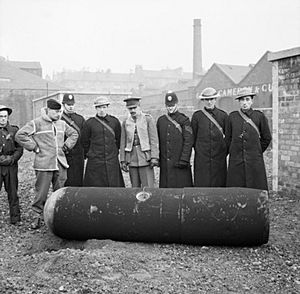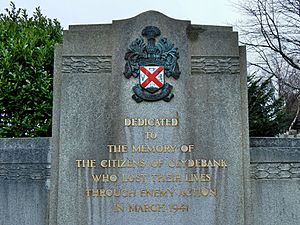Clydebank Blitz facts for kids
Quick facts for kids Clydebank Blitz |
|||||||
|---|---|---|---|---|---|---|---|
| Part of the Strategic bombing campaign of World War II | |||||||
 A defused 1,000 kg Luftmine (German parachute mine) in Glasgow, 18 March 1941 |
|||||||
|
|||||||
| Belligerents | |||||||
| Commanders and leaders | |||||||
|
|
||||||
| Casualties and losses | |||||||
| 1200 killed, 1000 wounded, 8500 homes destroyed or damaged | |||||||
The Clydebank Blitz was a series of air attacks by the German air force, called the Luftwaffe. These attacks happened in March 1941. They targeted Clydebank, a town in Scotland that built ships and made weapons. These bombings were part of a bigger plan known as The Blitz.
What was the Clydebank Blitz?
The raids happened on the nights of March 13 and 14, 1941. Clydebank suffered the worst damage and loss of life in all of Scotland during World War II. About 1,200 people died, and 1,000 were seriously hurt. Hundreds more were injured by flying debris.
Over these two nights, 439 German bombers attacked the town. They dropped over 1,650 containers of fire bombs and 272 tonnes of other bombs. Out of about 12,000 homes, only eight were left undamaged. Around 4,000 homes were completely destroyed. Another 4,500 were badly damaged. This meant over 35,000 people lost their homes.
Clydebank was a target because it produced ships and weapons for the Allies. Important targets included the John Brown & Company shipyard, the ROF Dalmuir factory, and the Singer Corporation factory. RAF fighter planes shot down two German aircraft during the raids. However, no planes were brought down by anti-aircraft guns.
Les Taylor, a historian, called the Clydebank Blitz "the most terrible event" in Scotland during the war. He believes the first night's raid was not meant to cause terror. However, it caused huge damage because many homes were close to the factories. The attacks on the second night, he says, were meant to scare people. The goal was to make them want the war to end. But it had the opposite effect. It made people in Scotland even more determined to fight.
How effective were the attacks?
Just west of Clydebank was a large oil storage facility for the navy. German maps showed this as the main target. After the raids, 96 bomb craters were found there. Eleven oil tanks were destroyed, and seven were badly damaged. The fires from these tanks burned for over four weeks.
Clydebank, which was very close, suffered greatly because of this. In 1941, Clydebank was a small industrial town. It was about 2 miles (3 km) long. The town area was just over 1.5 square miles (4 km²). It was hard for the bombers to hit only factories. This was because homes and industries were mixed together. This led to a huge loss of housing.
Many factories and industrial places were badly damaged. Singer's wood yard was destroyed. The main Singer building was also badly hit. Rothesay Dock and John Brown's Shipyards suffered severe fire damage. William Beardmore & Co lost furnaces and other important factory equipment. Schools, churches, and other town buildings were also hit by fire bombs.
Remembering the Blitz
The main memorial for the Blitz is in Dalnottar Cemetery, above Clydebank. It is a large granite memorial with bronze plates at its base. The artist Tom McKendrick designed it. The plates list the names of the 528 people who died. The memorial stands over the graves of those who were not claimed by their families.
Another memorial honors the crew of a Polish destroyer, ORP Piorun. This ship helped defend the town from the docks of the John Brown & Company shipyard. This memorial is right across from the Town Hall. The Town Hall itself has a shrine. It remembers those from Clydebank who died in World War I and World War II. There is also another war memorial on Graham Avenue. A recording from May 1941 by a civilian named Tom Wright, who lost his home, is on an audiobook CD called The Blitz. It was released in 2007.



